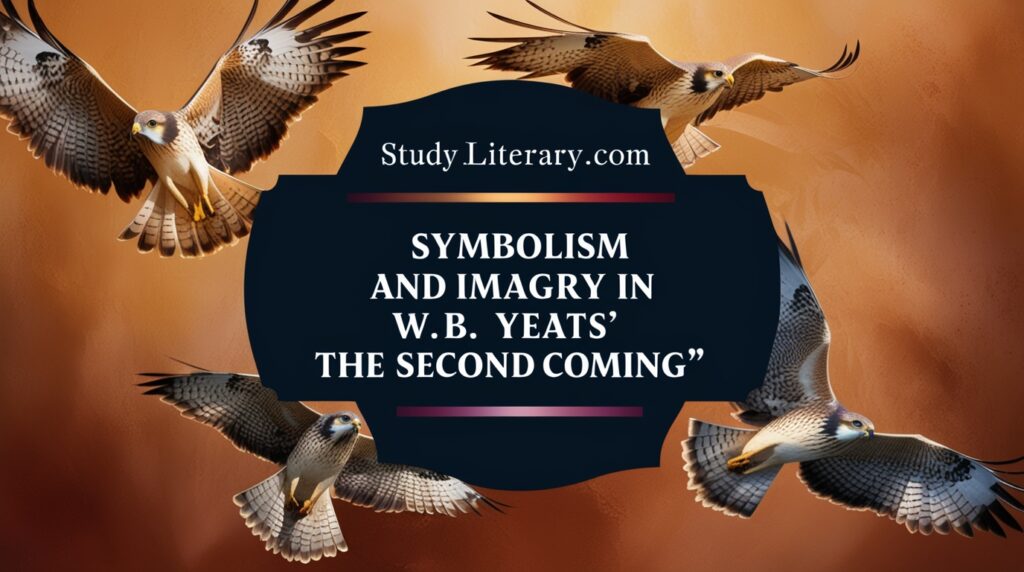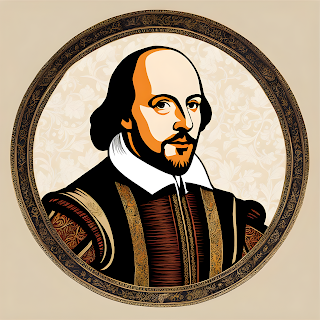
Symbolism and Imagery in The Second Coming by W.B. Yeats
W.B. Yeats’ The Second Coming is renowned for its haunting imagery and dense symbolism, which evoke a world in turmoil and on the brink of a catastrophic change. Written in 1919 during a time of intense global upheaval following World War I, the poem reflects Yeats’ sense of despair and foreboding about the state of civilization. The symbols and imagery Yeats employs in The Second Coming are not only vivid and memorable but are also deeply rooted in his personal vision of history, spirituality, and myth. Through his use of apocalyptic imagery, mythological symbols, and references to the cyclical nature of history, Yeats presents a grim and terrifying vision of a new era dominated by chaos and violence.
The Symbol of the Gyre
One of the most central symbols in The Second Coming is the gyre, which appears in the very first line:
“Turning and turning in the widening gyre / The falcon cannot hear the falconer.”
The gyre, a spiraling cone or vortex, is a key symbol in Yeats’ personal mythology. In his esoteric book A Vision, Yeats describes history as a series of interlocking gyres, each representing a 2,000-year cycle. As one gyre reaches its end, it expands and loses stability, leading to the emergence of a new era. The widening gyre in the poem symbolizes a world spiraling out of control, where the forces of order and structure are disintegrating. The falcon, traditionally a symbol of control and discipline, is no longer able to hear its falconer, representing a breakdown in communication, authority, and direction. This imagery conveys a sense of fragmentation and chaos, suggesting that the center—the force that holds society together—can no longer maintain order. The image of the widening gyre is a powerful metaphor for a civilization that is unraveling and heading toward inevitable destruction.
Apocalyptic Imagery: The Collapse of Civilization
The poem’s opening lines establish a sense of impending doom with imagery that evokes a world overwhelmed by anarchy:
“Things fall apart; the centre cannot hold; / Mere anarchy is loosed upon the world, / The blood-dimmed tide is loosed, and everywhere / The ceremony of innocence is drowned.”
These lines, which have become some of the most quoted in modern poetry, depict a world where the foundational structures—both moral and political—are collapsing. The phrase “things fall apart” suggests the disintegration of social, political, and spiritual order, while “the centre cannot hold” symbolizes the failure of any central authority or guiding principle. The imagery of the “blood-dimmed tide” suggests a flood of violence and bloodshed, where traditional values and societal norms are washed away in a tide of chaos. The drowning of “the ceremony of innocence” emphasizes the loss of purity and goodness in a world where the forces of destruction are in the ascendant.
This apocalyptic imagery reflects Yeats’ disillusionment with the state of the world following the devastation of World War I and the political turmoil of the time. The poem conveys a profound sense of disorientation, as if the world is on the brink of something unknown and terrifying. Yeats uses these powerful visual images to express a collective anxiety about the future, where the old order is collapsing and the new order remains uncertain, but likely malevolent.
Mythical Symbolism: The Sphinx and the Rough Beast
The most striking symbol in The Second Coming is the image of the “rough beast” introduced in the second stanza:
“Surely some revelation is at hand; / Surely the Second Coming is at hand. / The Second Coming! Hardly are those words out / When a vast image out of Spiritus Mundi / Troubles my sight: somewhere in sands of the desert / A shape with lion body and the head of a man, / A gaze blank and pitiless as the sun, / Is moving its slow thighs, while all about it / Reel shadows of the indignant desert birds.”
This “vast image” is a powerful symbol drawn from Yeats’ concept of Spiritus Mundi—the collective spirit or memory of the world that contains the archetypes and symbols of human experience. The rough beast is often interpreted as a monstrous, sphinx-like figure, representing the birth of a new, brutal era. The creature’s “lion body and the head of a man” suggest a blend of animalistic strength and human intelligence, but its “blank and pitiless” gaze reflects an inhuman and merciless force. This image, with its mythic resonance, suggests the arrival of a new civilization that is barbaric and devoid of compassion.
The setting in the desert, with “indignant desert birds” circling above, enhances the sense of desolation and barrenness. The rough beast slouches slowly toward Bethlehem, the site of Christ’s birth, suggesting that this new era is a dark parody of the Christian Second Coming. Instead of the return of a savior, Yeats envisions the rise of a malevolent force that will dominate the future. This inversion of the Christian symbol of redemption reflects Yeats’ belief that the current historical cycle is coming to an end, to be replaced by something far more destructive and terrifying.
Cyclical History and Symbolic Imagery
Yeats’ The Second Coming is deeply influenced by his belief in the cyclical nature of history. According to Yeats, history moves in cycles, with each era eventually giving way to its opposite. The poem’s imagery reflects this view, suggesting that the collapse of the current order is not just a moment of chaos, but the prelude to the birth of a new and darker age. The rough beast symbolizes the culmination of this historical cycle—a brutal force that will replace the decaying remnants of the old civilization.
The imagery of birth and gestation is also significant in this context. The “rough beast” that “slouches towards Bethlehem to be born” suggests that the world is entering a new phase, but one that is marked by violence and destruction rather than renewal or salvation. This birth imagery conveys the inevitability of the historical process—just as the Christian era was born with the arrival of Christ, so too will this new era be born with the emergence of the rough beast. The symbolic movement towards Bethlehem reinforces the idea that this is a turning point in history, where one cycle ends and another begins.
Themes of Duality and Opposites
The symbols and imagery in The Second Coming are also rich in themes of duality and opposites. The title itself refers to the Christian concept of the Second Coming, which traditionally represents hope, salvation, and the fulfillment of divine prophecy. However, Yeats subverts this expectation by presenting a vision of a Second Coming that is dark, ominous, and destructive. The poem’s imagery juxtaposes concepts such as civilization and barbarism, innocence and corruption, creation and destruction. These opposites reflect Yeats’ belief that history is governed by cycles in which every positive force is eventually replaced by its opposite. The imagery of the widening gyre, the falcon and the falconer, and the rough beast all convey this idea of a world in transition from one extreme to another.
Conclusion
W.B. Yeats’ The Second Coming is a poem rich in symbolism and imagery that powerfully conveys a vision of a world in crisis. Through the use of symbols such as the gyre, the rough beast, and the apocalyptic tide, Yeats explores themes of chaos, the collapse of order, and the cyclical nature of history. The imagery in the poem—from the falcon spinning out of control to the pitiless gaze of the sphinx-like creature—creates a sense of profound unease, capturing the anxieties of a world on the brink of an unknown and terrifying future. By drawing on myth, history, and personal symbolism, Yeats crafts a poem that remains hauntingly relevant, speaking to the fear and uncertainty that accompany moments of profound change. The powerful symbols and vivid imagery of The Second Coming ensure its place as one of the most significant and enduring poems of the modern era.

